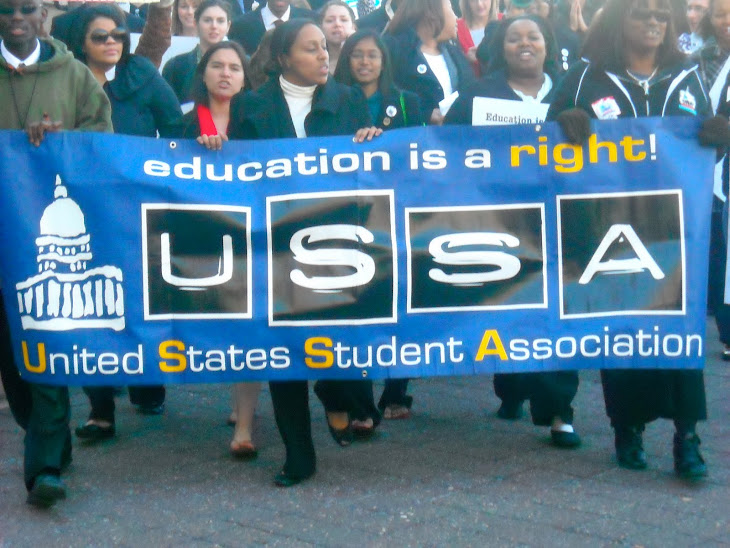
This March, millions of young people are rallying nationwide in energetic crowds, chanting, singing and holding up signs, funneling their idealistic passion into a single cause of great importance to college students. Sounds like the annual uproar surrounding NCAA basketball, right? Well, this is a different kind of March Madness.
Throughout the first week of March, college students organized over 120 actions in over thirty states to rally against the historic divestment from higher education. There was a laundry list of grievances to protest. The Pell grant, once the cornerstone of student aid, has plummeted from covering seventy-two percent of the cost of college to just thirty-two, tuition increases have skyrocketed into the double-digits as states balance their budgets by slashing higher education funding, two-thirds of students are taking out mortgage-sized loans to pay for college, sending the average borrower nearly twenty-five thousand dollars in debt at graduation, and, as with the rest of America, students continue to struggle in one of the worst job markets on record. So students spoke up and displayed a new kind of March Madness through massive 1960-style rallies, demonstrations, and marches.
These actions go far beyond exorcising the frustration felt by the nation’s debt-ridden students. On March 20-23rd, over five hundred students are taking this vigor and enthusiasm to Capitol Hill to urge their Senators to pass a student aid reform proposal that has recently been included in the budget reconciliation bill. The proposal, which mirrors the Student Aid and Fiscal Responsibility Act, encompasses President Obama’s plan to reform the student lending industry by eliminating the Federal Family Education Loan Program (FFELP), which allows the government to heavily subsidize private lenders to originate and service federal student loans. Ending this program would save tens of billions of dollars that would go directly to students, through the aptly named Direct Loan Program, via increases to the Pell grant, low-interest rate Perkins Loans, access and completion programs, and investments in Minority-Serving Institutions. Because all of these investments are paid for by funds that would have gone towards bank subsidies, the legislation doesn’t cost the taxpayers a dime.
Students overwhelmingly support the proposal. During the 2009 National Student Congress, student aid reform was unanimously passed as a top legislative priority for the United States Student Association, which represents over 4.5 million college students. Hundreds of student governments have subsequently adopted resolutions supporting the Student Aid and Fiscal Responsibility Act, and hundreds of thousands of students have contributed to a national “wall of student debt” with paper “bricks” exhibiting their personal and financial struggles to pay for college. More recently, in the past few days since Senator Tom Harkin and Congressman George Miller announced that student aid reform would be included in budget reconciliation, college students sent over two thousand letters to Congress expressing support for this action. Despite being swamped with debt, class loads, and an increasingly dire job prospects, on top of being the second most uninsured demographic for healthcare, college students have mobilized a coast-to-coast grassroots campaign to pass student aid reform. National in breadth and substantive in depth, the campaign is moving from street protests to the Halls of Congress.
As with most underdogs, there is a Goliath to the students’ David. The nation’s top private lenders are waging their own political campaign to stop student aid reform. Lenders’ Political Action Committees (PACs), high-priced lobbyists, and million dollar warchests are mounting a formidable opposition to students and their prized legislation. In 2009, lenders spent about four million dollars on lobbying; that’s the equivalent of twenty-five thousand dollars for every day Congress was in session last year. PACs for lenders made over two million dollars in political contributions, with Sallie Mae’s PAC leading the pack with 194,000 dollars in donations. So while students invest what little time and resources they have in passing real reform, big banks are pouring millions of dollars into obstructionist lobbying tactics aimed at maintaining a status quo that perpetuates a lending system that has led to the greatest amount of student debt in history. These tactics may have swayed legislators from states with big lending influences, but students have not been fooled. And while students may not have the kind of money that lenders so freely spend on lobbying, young people have power in numbers and passion and will bring both to Capitol Hill this weekend to fight for loan reform.
Against overwhelming odds, America’s youth has always fought the institutionalized, business-as-usual policies that garner profits over the advancement of socioeconomic justice. Like their Great Society predecessors, today’s college student activists are our nation’s conscious. And as March maddens, the fight for student aid reform is moving from local protests to the Nation’s Capitol. Bring on the madness.

i am so glad and proud of the students for speaking up and out about the cuts to their education. it is downright unfair and ridiculious to jeopardize their futures like that education is a right for everyone and if we all stand together and fight the good fight ten we will all win its too much politics that are playing with all the students and it is not right
ReplyDeletePlease visit our website.
ReplyDeletewww.Natl-Econ-Move.info
Your Education Rights will NEVER be in jeopardy when you KNOW and USE "Your Economic Rights".
We are Senior Citizens looking for persons with progessive attitudes to implement a unique plan that will give the masses of people the true political control.
Our plan will also give students the financial resources for businesses and wealth buiding during and after college.
Would someone from your association contact us?
Thanks